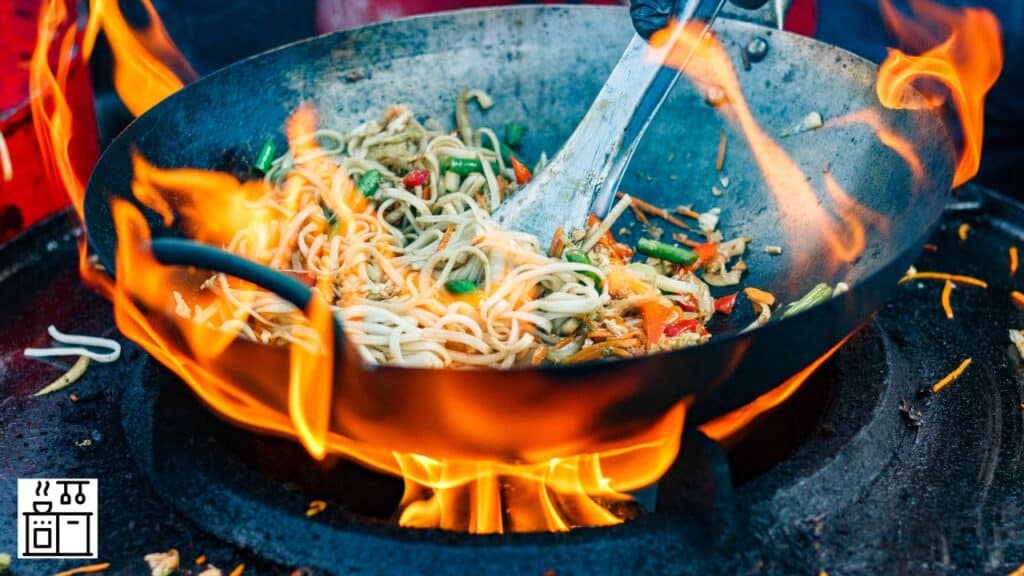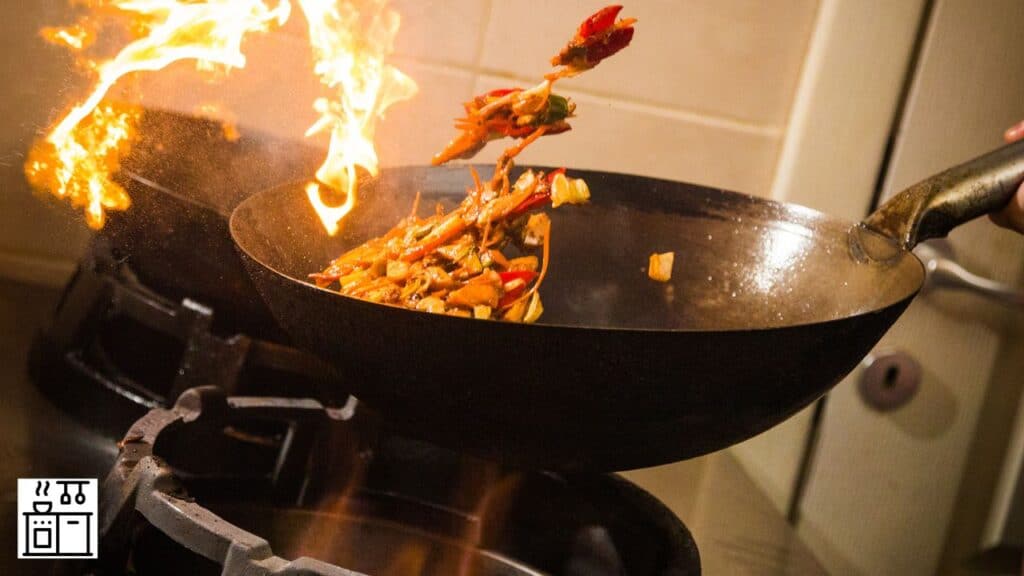A wok is a cooking utensil with a dome-shaped base and high walls. It can either have a long handle or two open-loop handles on either side.
A wok is typically 12” to 14” in diameter. It’s widely used in Asian and Chinese cooking. It enables cooks to whip up perfect fried vegetables, meat, or fried rice.
The unique shape and construction of a wok make it different from typical frying pans and other kitchen utensils.
A wok achieves high temperatures very quickly. It’s also a big vessel that takes time to get used to.
So, here are the steps to use a wok efficiently.
1. Identify the Type of Wok
Traditional woks are made of carbon steel. However, you may find woks that are made of non-stick material, stainless steel, and other construction materials too.
The properties of the utensil will be affected by the material used for construction.
If your wok is made of carbon steel, you must season the wok before use.
Seasoning will transform the shiny silver color of the wok to black because of the formation of a patina.
Food glides and doesn’t stick to the surface of a seasoned wok.
To season it, simply add some oil and swirl it around while it’s still heating. Then, pour that oil off, and your wok is ready for cooking.
2. Choose the Right Type of Oil
Woks reach high temperatures when placed on a heat source. Hence, it’s important to choose an oil that doesn’t break down at such high temperatures.
Oils with high smoking points, like groundnut oil, canola oil, peanut oil, grapeseed oil, and avocado oil, are suitable.
They are stable at high heat, making them better for cooking.
However, some of these oils, like peanut oil and coconut oil, have a strong aroma and distinct flavor.
This will alter the taste and flavor of the food you cook in the wok. Keep this factor in mind when choosing an oil for cooking.
3. Add Ingredients in The Right Order for The Best Results
Cooking in a wok is different from cooking in other utensils. The order in which you add ingredients matters.
You can play around with the ingredients to a certain extent. Nevertheless, here is how we recommend you add the ingredients to a wok.
Start with Protein
Thinly sliced or chopped meat, chicken, seafood, tofu, or pork should ideally go first.
These proteins will need four to seven minutes to cook properly.
Depending on the recipe, you can either let them remain in the wok while the rest of the ingredients cook or take them out once they are done.
Add the Aromatics Next
Shallots, leeks, garlic, onions, carrots, and celery are commonly used aromatics.
These ingredients will quickly integrate into a dish. They cook swiftly and will need only a minute or two to be done.
Cook Vegetables
Vegetables that form the bulk of the dish, like broccoli, cauliflower, and potatoes, are next.
The cooking time, in this case, depends on the size and the density of the vegetable.
Some vegetables like broccoli and potatoes can take longer than greens to cook.
So, plan the cooking time based on the type of vegetable. Most vegetables don’t need more than seven minutes for cooking.
Finally, Add the Starch and Sauce
At the final stage, you can add starchy ingredients like rice or noodles. Simultaneously add the sauce and flavoring ingredients.
Most experts like to add sauces like soy sauce and fish sauce along the sides of the wok.
This helps them caramelize before reaching the rest of the ingredients.
But it’s necessary to quickly toss and mix the ingredients after adding the sauce to prevent it from burning.
So, it’s a tricky method that requires practice to master.
4. Toss and Mix the Ingredients While Dragging the Wok Around

The traditional way of cooking with a wok is to gently use small pushes and pulls to constantly move the wok.
This is done without lifting it off the stove. You should also use a spoon to aid the mixing process.
When the ingredients are partially cooked, you can lift the wok off the surface.
Toss and flip the ingredients for a few minutes before setting them back down.
The best thing about using a wok for cooking is that it has enough area for all the ingredients to mix and integrate.
The handles make it easy to drag and push along the stove for proper mixing.
Tossing and flipping make the entire process very dramatic and exciting to watch. However, it’s also very effective in getting the mixing done well.
Proper tossing, flipping, and folding lowers the cooking time and helps the dish develop better flavor.
5. Adjust the Cooking Method for Each Type of Stove
It’s easy to quickly drag and toss the wok up and down on a gas-powered or electric-powered stovetop.
On a gas stove, this process makes the flames rise upwards along the sides, heating the wok easily.
If the wok is made of carbon steel, this will drastically speed up the cooking process.
However, such constant movement may not be possible on an induction cooktop or a gas burner with a glass surface.
These stoves have delicate cooking surfaces. So, constantly dragging and pushing a metal wok on the surface can damage it.
The glass can crack, and the internal heating element can become damaged.
In this case, the better choice is a flat-bottom wok. You can use a wooden spoon to properly mix the ingredients.
It will still produce good results, though the smoky flavor may be less.
6. Woks Can Be Used to Make Dishes Apart from Stir-Fries
When we think of cooking with woks, stir-fry dishes first come to mind.
It’s widely used to stir-fry vegetables and meat and prepare fried rice.
However, woks can be used to make much more than just stir-fries. They include the following.
- Shallow frying and deep frying: The unique shape of a wok makes it highly suitable for shallow and deep frying of ingredients. The metal builds heat quickly and distributes it evenly. So, you can comfortably use it for deep frying and shallow frying. The main benefit of using a wok for frying is that the process takes less time. The food cooks better and achieves a beautiful brown color.
- Steaming: You can use a wok for steaming dumplings and other cooking ingredients. The best way to do this is to fill the base of the wok with water and place a bamboo steamer or metal colander inside the wok with the cooking ingredient.
- Boiling: You can boil vegetables or meat in a wok. Its unique shape will make the water boil quickly, while high heat will help the ingredients cook faster in a wok.
- Making curries and stews: You can use a wok to make curries and stews. The process begins with tempering aromatic ingredients, followed by adding the rest of the ingredients for the curry or stew. The deep and wide base has enough space for the liquid that goes into the dish.

